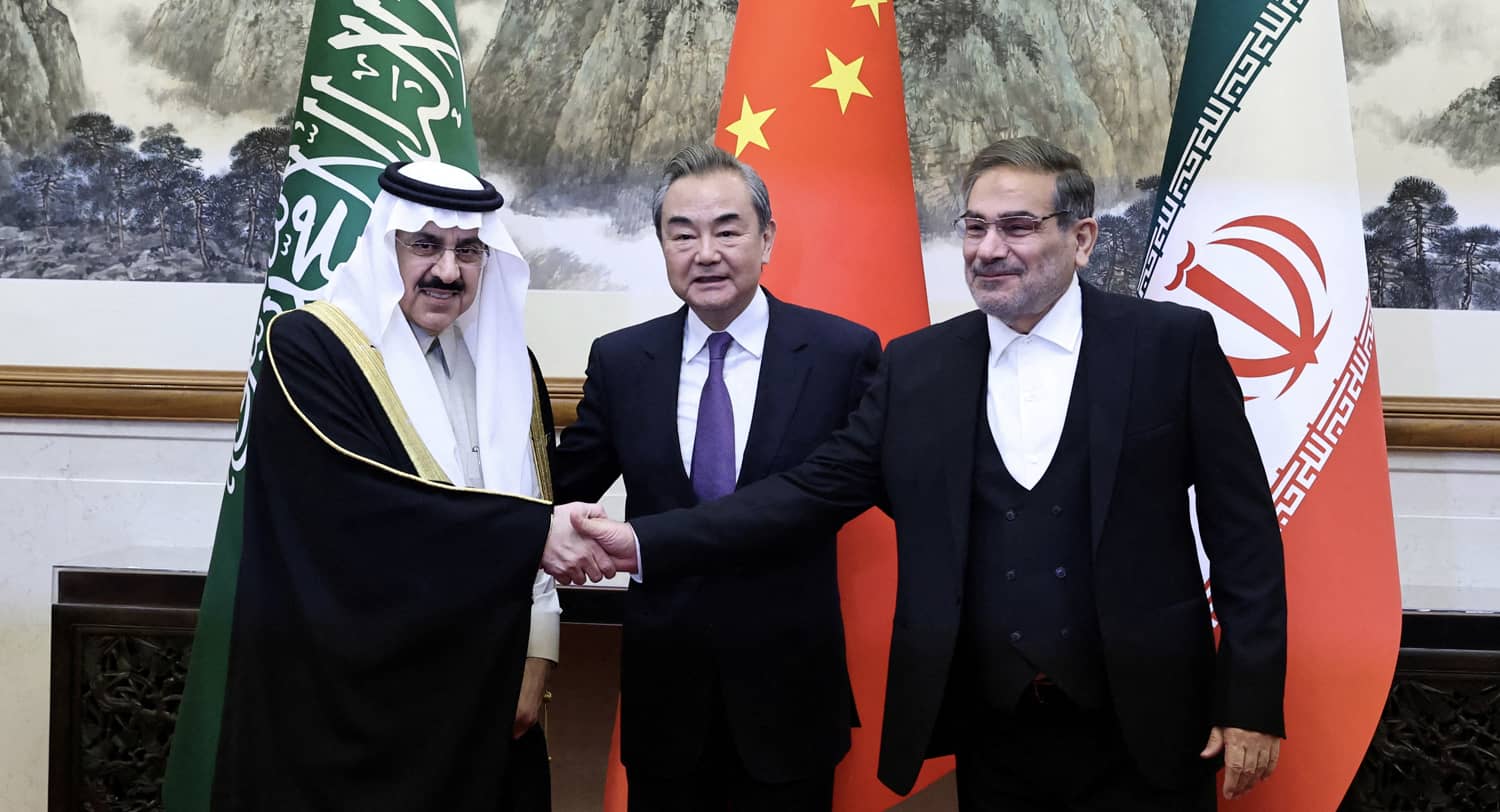Described by the New York Times as “the topsiest and turviest of developments” and “a shift that left heads spinning,” the recent agreement brokered by China for Saudi Arabia and Iran to reestablish diplomatic relations caught many in the US foreign policy establishment flatfooted. It is a testament to the groupthink, which still pervades Washington 20 years after the invasion of Iraq, that Beijing’s diplomatic success was a “surprise,” as one Wall Street Journal contributor put it. While successive US administrations, both Democratic and Republican, have focused on achieving discrete, concrete deliverables in the Middle East, American policymakers and analysts have refrained from remarking on the broader evolution of the region’s geopolitical and geoeconomic dynamics occasioned by China’s emergence as a major actor. The timing of the pact might not have been predictable, but the breakthrough was most certainly a long-distance trek.
A Long Prelude
Contacts between the greater Middle East and China go back at least 15 centuries, with Persian and Arab merchants and diplomats following the Silk Road to its eastern terminus at present-day Xi’an, capital of the Tang Dynasty (618–907), as well as traveling to the Middle Kingdom by sea through the Spice Islands to southeastern ports like Guangzhou (Canton). From at least the period of the Mongol conquest and the subsequent establishment of the Great Yuan Dynasty (1271–1368), China’s rulers increasingly viewed it as a “national security affair” (guoji gongshi) to bind the peoples of the Central and West Asia to the Chinese empire, either through direct conquest or commercial ties. The annexation of what is today known as Xinjiang (“the new frontier”) by the Qianlong emperor (1735–1796) brought under the Chinese state large Muslim communities whose cultural and religious connections to the Middle East continued to be nurtured by the hajj to Mecca and itinerant preachers hailing from Arabia.
At the time of the founding of the People’s Republic of China (PRC) in 1949, Beijing’s strategic interests in the Middle East were limited. Initially, Mao Zedong and the Chinese Communist Party followed the lead of the Soviets, proclaiming that their foreign policy was “precisely the same as the Soviet Union’s foreign policy” in general and, specifically, that “the Chinese people take the same positions as those of the Soviet Union and fully support the Middle East people in their struggle against imperialism.” Unlike their Soviet counterparts, who were the first government to grant de jure recognition to the Jewish state in 1948, Beijing’s new rulers spurned Israel and adhered to the dogma in which Israel was an arm of the imperialist enemy. This policy did not change even when in 1950, notwithstanding the long-term active support of Zionism by Chiang Kai-shek’s Nationalists and the Republic of China’s vote in favor of Israel’s admission to the United Nations, the Jewish state became the very first Middle East government to recognize the PRC as the government of China.
After Joseph Stalin’s death in 1953 and the ensuing Sino-Soviet split, however, Chinese national interests began to take precedence over communist ideology. Painfully aware of the lack of support they had within the communist bloc and diplomatically isolated as a result of the continuing recognition of the Nationalist regime on Taiwan at the UN and other international organizations, the PRC began to seek allies against both “U.S. imperialism” and “Soviet revisionism” in the newly independent countries and national liberation movements of Asia and Africa, with whose leaders Beijing stressed the common experience of colonial oppression and the need to defend political sovereignty and territorial integrity of their nascent states against the encroachments of both superpowers.
At the 1955 Bandung Conference, representatives of 29 African and Asian countries—including Afghanistan, Egypt, Iran, Iraq, Jordan, Lebanon, Libya, Pakistan, Saudi Arabia, Syria, Turkey, and Yemen, among the Middle Eastern states—endorsed the “Five Principles of Peaceful Coexistence.” These principles—mutual respect for sovereignty and territorial integrity, mutual nonaggression, noninterference in internal affairs, equality and mutual benefit, and peaceful coexistence—were first articulated by Chinese Premier Zhou Enlai as the basis for relations among the emergent nations of the developing world and confirmed China’s status as a leader of these nations.
One year later, in 1956, Egypt became the first Arab country to establish full relations with Communist China. When Nasser nationalized the Suez Canal just two months later, Beijing extended to Cairo a loan of 20 million Swiss francs, which it could barely afford itself, and offered rolled steel and other materiel. In return, Nasser facilitated the PRC’s entrée to Yemen, whose government signed a Treaty of Friendship with China in 1958, which included scientific, technical, and cultural exchanges as well as a Chinese loan. Within the year, presaging what was to come, some 1,000 Chinese workers were building a highway to connect Sanaa and the Red Sea port of Al Hudaydah. The drawback of relying on its close partnership with the pan-Arab nationalist Nasser, which lasted until he pivoted toward the Soviet Union, was that China consequently found that it was given the cold shoulder by the conservative monarchies of the region, some of which refused well into the 1970s to recognize the government in Beijing.
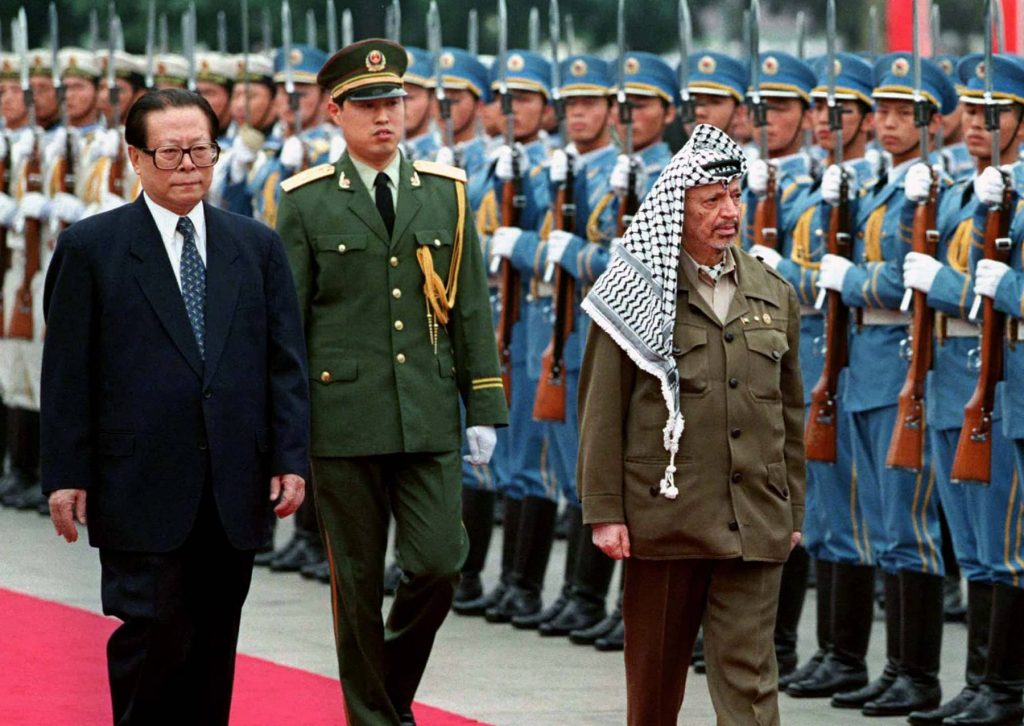
The creation of the Palestine Liberation Organization (PLO) at a Cairo summit of the Arab League in 1964 provided a new opportunity for Chinese involvement in the Middle East. Even before the formal establishment of the PLO, China had hosted a visit by Yasser Arafat and Khalil al-Wazir, two of the co-founders of Fatah, the party that would eventually become the largest faction within the Palestinian movement, during which huge demonstrations were held in support of the Palestinians’ “right of return” to their homeland. Ahmad Shuqairy, the first chairman of the fledgling PLO, was invited to Beijing in 1965 and was received like a visiting head of state by Mao, Zhou, and other top leaders. The final communiqué of that visit pledged China’s “resolute support” for the Palestinian cause. Subsequently, the PRC began to supply weapons to the Palestinian groups whose revolutionary agenda resonated with the then-regnant ideology within the Chinese Communist Party as it plunged through the Cultural Revolution, even though several of Beijing’s Arab allies opposed arming the Palestinians.
Mao’s death in 1976 and the emergence of Deng Xiaoping as China’s paramount leader led to a shift in Beijing’s priorities, both at home and abroad. Although China continued to reiterate the Five Principles as the basis for international relations, China’s new leaders became more concerned about the “Four Modernizations” (agriculture, industry, technology, and defense) at home than revolutionary solidarity abroad. At the same time, with the steady collapse of the Soviet Union in the 1980s, Beijing no longer acutely felt the need to compete with Moscow in burnishing its Third World credentials and gradually established full diplomatic relations with all governments in the Middle East, including those it had hitherto shunned: the United Arab Emirates (1984), Qatar (1988), Bahrain (1989), Saudi Arabia (1990), and, finally, in 1992, more than four decades after having rebuffed Foreign Minister Moshe Sharett’s offer of recognition, with the State of Israel.
Fueling the Drive
As a result of the reforms adopted under Deng, China’s economy expanded rapidly to become by the end of the Cold War the third largest in the world, after the United States and Japan. This growth led, in turn, to an exponential increase in demand for energy. Despite an abundance of oil and gas, especially in its western Xinjiang Uyghur Autonomous Region, the development-driven demand for energy became so heavy that, by 1993, China had become a net petroleum importer. Chinese officials openly admitted that securing access to oil abroad was essential if their country’s pursuit of a “peaceful rise” (heping jueqi) was to be sustained.
Thus, Beijing embarked on a new round of engagements, this time driven by its need for energy, with the countries of the Middle East. Initially, China’s principal petroleum suppliers in the region were Oman and Yemen, whose light, low-sulfur (“sweet”) crude Chinese refineries found easier to process. However, as China’s voracious appetite for energy quickly surpassed the limited production capabilities of these two small states, deals were soon struck to buy oil from Iran, Saudi Arabia, the UAE, Iraq, Kuwait, and Qatar as well as non-Persian Gulf producers like Algeria, Egypt, and Libya. By the turn of the century, the Middle East accounted for more than 54% of China’s total crude imports.
Recognizing Saudi Arabia’s preeminent place among the Middle East oil producers, the PRC has cultivated what former president Jiang Zemin has described as a “strategic oil partnership” with the desert kingdom. In 1999, accompanied by a delegation of businessmen, Jiang paid what was the first-ever visit to Saudi Arabia by a Chinese head of state. During the trip, agreements were signed whereby the Saudis opened their oil and markets (except for “upstream” exploration and production) to Chinese investment, and, in return, the Saudi national oil company, Saudi Aramco, was allowed to participate in China’s “downstream” refining sector.
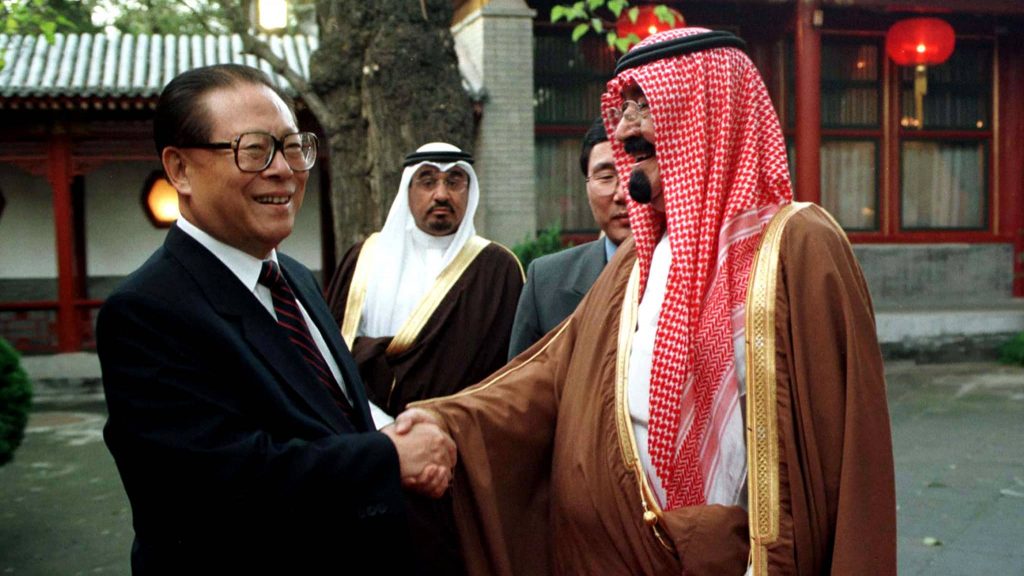
Saudi Arabia quickly became China’s leading foreign supplier of petroleum, while the Chinese gained from the Saudis advanced technology to improve the exploitation of their existing domestic oilfields. US regulations excluded China from accessing these technologies in the US owing to restrictions on the export of dual-use and other strategically sensitive items. The PRC also relied on Saudi expertise to increase its capacity to process heavy crude, cutting its dependence on selective brands of oil, which had previously led to occasional supply shortages.
The Sino-Saudi relationship grew so tight that in 2006, the newly enthroned Saudi monarch, Abdullah, made a visit to the Beijing in what Jiang’s successor, Hu Jintao, dubbed the “Three Firsts” (the first-ever visit by a Saudi monarch to China, the first country visited by Abdullah after his succession to the throne, and the first stop on the ruler’s multi-country tour). A few months later, when Hu reciprocated the visit, the two leaders signed five additional accords, expanding Sino–Saudi economic cooperation, including in the oil, gas, and mineral sectors, solidifying Riyadh’s role as China’s top energy supplier, and creating ever-increasing interdependencies between the two countries. In 2009, Hu made a second state visit to Saudi Arabia, which was highlighted by the signing of a major public works agreement for the first time between the two countries—a contract for the China Railway Construction Corporation to build a high-speed railway linking Islam’s two holiest shrines, Mecca and Medina (the project was completed in 2018).
Iran, the second largest oil producer in the Middle East, has also been the object of sustained Chinese courtship or, rather, the renewal of ancient ties dating back to their respective imperial pasts. In October 2004, the two countries signed a $100 billion agreement allowing the China Petroleum and Chemical Corporation (Sinopec) to produce and export up to 10 million tons of Iranian liquefied natural gas (LNG) annually for 25 years. The accord also provided for the construction of a refinery for natural gas condensates and a Chinese stake in developing Iran’s Yadavaran oil field. Earlier that same year, another Chinese oil firm, the China National Petroleum Company (CNPC), bought a 49% stake in Iran’s oldest oil field, the Masjed Soleyman, from a Canadian firm for an undisclosed sum. In 2006, a third major Chinese oil firm, the China National Offshore Oil Corporation (CNOOC), signed a deal involving up to $16 billion in investments to develop Iran’s North Pars gas field in the Persian Gulf. The following year, CNPC announced an agreement to develop part of the South Pars natural gas field, pledging to invest $1.8 billion in exploration and another $1.8 billion in the construction of an LNG plant.
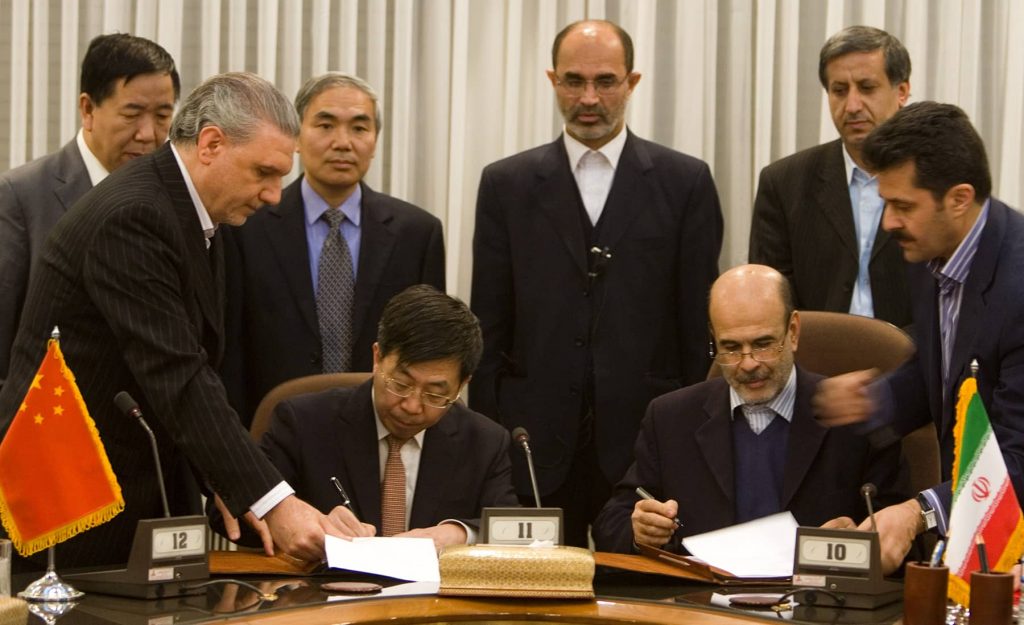
While energy-related transactions still dwarf everything else, there has also been a sustained uptick in overall Sino–Middle East trade, making China the region’s largest trading partner. The volume of Chinese trade with the Gulf states alone was just under $200 billion on the eve of the COVID-19 pandemic. Since 2016, China has also been the region’s largest source of foreign investment, including significant investments in marketing infrastructure like the 1.2 kilometer-long, 150,000-square meter “Dragon Mart” in Dubai, the largest trading hub for Chinese products anywhere outside mainland China.
Even amid the downturn in global trade during the pandemic, China continued to forge ahead with its Belt and Road Initiative (BRI) engagements in the Middle East, which received the largest share of BRI funding of any region in 2022 according to an authoritative Fudan University report. Saudi Arabia alone was the second-largest recipient of BRI investment globally last year. China has also found receptive partners in the Gulf for the “Digital Silk Road” program, the technology component of the BRI.
Diplomatic and Other Forays
If the quest for energy and business opportunities ranks high in Beijing’s priorities in the Middle East, it does not necessarily imply that Beijing has forgotten about geopolitical calculations. China long adhered to the ancient Chinese political maxim of zuoshan guan hudou (“sit on top of the mountain and watch the tigers fight”), under the banner of promoting “democracy in international relations” (guoji guanzi minzhuhua; that is, a more multipolar political and economic global order). But under Xi Jinping, China has taken an active diplomatic role in the region with his commitment to “comprehensive national power” (zonghe guoli) to reshape the “international balance of forces” (guoji liliang duibi) in order to advance the “Chinese dream” (Zhongguo meng) of not only national rejuvenation but also global dominance.
Emerging from his self-imposed pandemic quarantine, Xi has certainly focused on the Middle East, making Saudi Arabia the destination for only his third international foray since the outbreak of the coronavirus. During the three-day visit in December 2022, Xi met with King Salman and Crown Prince Mohammed bin Salman and attended a China–Gulf Cooperation Council meeting as well as the first-ever China–Arab States Summit in the Saudi capital.
At the end of 2008, in response to the spike in attacks on commercial shipping in the Gulf of Aden by Somali pirates, China sent three People’s Liberation Army Navy (PLAN) ships to join the navies of the United States, the United Kingdom, Russia, India, Turkey, and other countries as well as the European Union’s first-ever naval task force in patrolling the waters between Africa and Arabia. The PLAN flotilla represented China’s first extended naval deployment outside the Pacific area since the fabled voyages of Admiral Zheng He during the Ming Dynasty in the 15th century and, coincidentally, to the very same waters off the southern part of the Arabian Peninsula and the eastern coast of the African continent.
Despite the disappearance of Somali piracy, Chinese patrols continue with 40 more PLAN task forces, including over 120 ships, having rotated in and out of those waters through which about 10% of global trade passes. In 2017, China opened its first overseas military base in Djibouti, the small African state astride the Bab el-Mandeb strait connecting the Red Sea (and the southern approaches to the Suez Canal) with the Gulf of Aden and the Indian Ocean. While officially a “support facility” for the PLAN anti-piracy patrols, the base is a stone’s throw from nearby American, French, and Japanese military installations. Given the approximately 2,500-kilometer radius they can achieve without aerial refueling, any Shaanxi Y-8 maritime patrol aircraft based here could easily fly reconnaissance over most of the Arabian Peninsula and northwest Indian Ocean as well as cover Egypt and Libya to the north.
Growing arms sales to the region have served to advance Chinese foreign policy objectives. Moreover, these deals have taken on a life of their own as the weapons and technologies transferred are passed on by the regimes purchasing them, thus altering the regional balance of power. For example, thanks to Chinese help, Iran has developed the Noor, a radar-guided long-range anti-ship missile based on China’s Yingji-82 (C-802). During Israel’s 2006 conflict with Iran’s Lebanese protégé terrorist group Hezbollah, the Israeli Navy’s Sa’ar 5-class corvette Israeli naval ship Hanit was struck with an Iranian-supplied Noor, which set the deck on fire and crippled the ship’s propulsion system. Four sailors were killed during the attack, which took the Israeli military by surprise as they had not counted on Hezbollah possessing that capability. More recently, the Houthi rebels have repeatedly fired solid-propellent missiles at airports, oil fields, and other targets in Saudi Arabia and the UAE; these so-called Qaher series tactical ballistic arms are derived from the Iranian Fateh-110, which is itself based on Chinese technology.
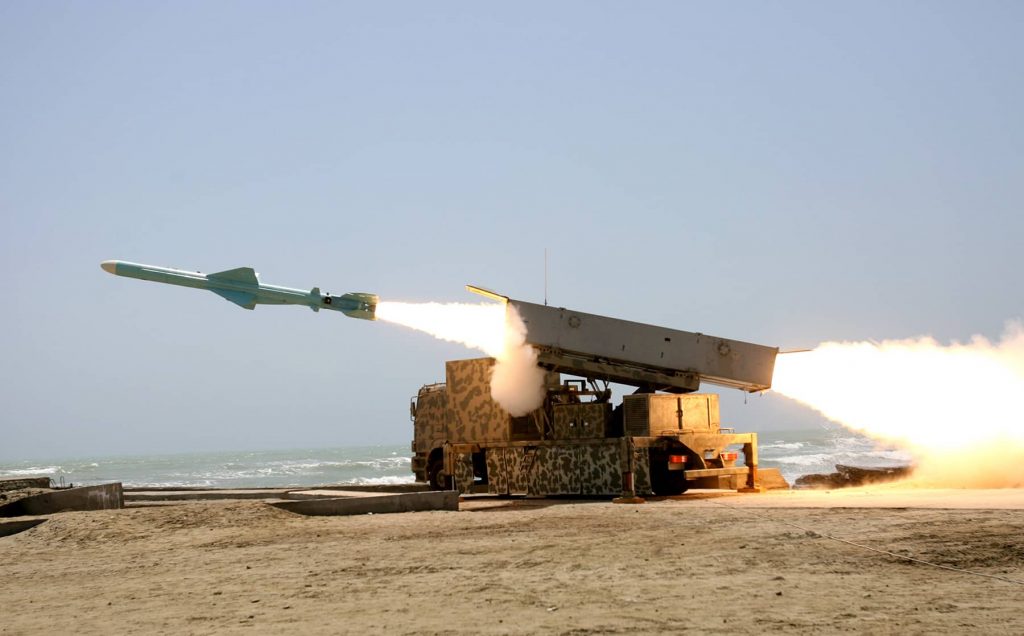
In 2019, China launched a Middle East Security Forum as an alternative forum for managing conflicts in the Gulf as well as discussing the Palestinian issue. A second meeting of the Forum took place in Shanghai in 2022 under the chairmanship of then State Councilor and Foreign Minister Wang Yi and adopted the position that the implementation in the Middle East of the Global Security Initiative, announced by Xi earlier in the year, would “help regional countries address development and security challenges, provide fair and reasonable solutions to regional hot-spot issues, and create a new framework for common, comprehensive, cooperative, and sustainable security.”
China’s new chief diplomat, formerly Beijing’s ambassador in Washington, used a speech about the Global Security Initiative to hint that the agreement between Riyadh and Tehran was in the works three weeks before it was ultimately announced: “On the Middle East, China welcomes and supports security dialogues among regional countries, including Saudi Arabia and Iran, as well as regional efforts to build a Middle East security architecture that suits the realities of the region and accommodates the interests of all parties.”
What Next?
Hosting the restoration of relations between Iran and Saudi Arabia is no doubt a significant feather in Beijing’s cap, even if this Iran–Saudi commitment remains limited. In the short term, this diplomatic achievement probably confirms in Xi Jinping’s mind the truth of the Maoist aphorism that he revived, “the East is rising, the West is declining” (dongsheng xijiang). Certainly, neither American nor Israeli interests are served by closer ties between China, Saudi Arabia, and Iran.
But it is not altogether clear that there is much common interest in the agreement other than the leverage that each of the two signatories hopes to achieve from the pact for its own objectives. Saudi Arabia may believe this agreement will increase the pressure on the Biden administration to meet the kingdom’s purported demands for security guarantees and assistance with a civilian nuclear program in exchange for diplomatic relations with Israel. The Saudis know that, at least for now, only the United States is capable of providing the security umbrella needed as the Iranian mullahs draw ever closer to having nuclear weapons and their regional proxies have yet to be restrained. In fact, just days after the Chinese-brokered agreement with Iran took place, Saudi Arabia reinforced economic ties with the US by concluding one of the biggest sales ever signed by the Boeing Company, ordering 78 of the 787 Dreamliners and taking out options on another 43, a $37 billion deal that the White House hailed as a “landmark.”
At the same time, however, the Saudis—and, indeed, other Gulf states—do not want to be diplomatically or militarily beholden to any one power. In fact, given America’s own diminished reliance on Middle East oil and gas, it would be absurd to think that Arab energy producers would not want warm relations with their biggest market.
Even if the Chinese-hosted agreement between Saudi Arabia and Iran took the US administration by surprise, there is no excuse for Washington not having seen the burgeoning economic, political, and security ties that Beijing has progressively and methodically cultivated throughout the greater Middle East region since at least the death of Chairman Mao. American leadership in the region remains an imperative—and it begins with careful attention to the long-term trends and the resulting geopolitical and geoeconomic dynamics as well as a commitment to stay on course for the entire race.
